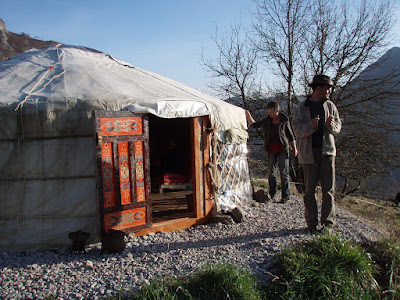
Luis here:
With the beginning of Spring, we are experiencing a period of warm sunshine and longer days during which, planting in the vegetable plot has continued. The three varieties of onions reds, whites and early salad ones that I got from the local market, four hundred of them, all have rooted. Seeds of beetroots, spring onions, mangetout, peas, carrots and lambs lettuce will hopefully start germinating soon now that the soil is warmer. As you can see, at this time of the year the vegetable plot requires some time. I have also been experimenting further with the mosaic making to create human and animal shapes.

Not all has been work while Ian has been in the UK visiting family and friends. I have enjoyed some lovely walks in the mountains and coast. I organised some of the walks in the heart of the Picos National Park and was joined by Luis and Tina who both live in Toriello. I was also up in the mountains with a friend, Nigel on two of the most incredible walks in different parts of the region, Piloña and Caso where we climbed Pico Vizcares with 1420 m high and Peña Crespa just a bit taller at 1521 m and a 10 hour walk. Both walks were fabulous with stunning views of remote mountain areas, valleys and high pasture meadows. It would have been difficult for me to do this walks if Nigel, who knows the mountains very well, had not kindly taken me with him. We did not see as many wild animals as we expected but the abundance and range of wild flowers made up for that, daffodils, dogs tooth lily, cowslip, primulas and hepaticas to name a few. In the second ascent we were lucky enough to see all four types of the asturian wild daffodils, some of them in such huge numbers- such a treat! We also gained an insight into the lives of the shepherds by visiting some of the cabañas (shepherd´s huts) dotted along the way. The cabañas are stone buildings in beautiful environments traditionally used by the shepherds when they took the livestock grazing up into the mountain meadows during Summer. Sadly many of them now are deteriorated as there are very few shepherds left.






